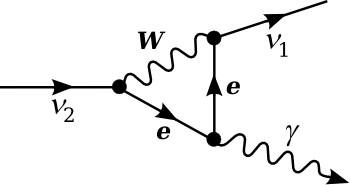Dark Matter Detected?
January 8, 2015
As a
child, the only
chocolate I knew was
milk chocolate, an inexpensive chocolate composition having just 10% chocolate content by
US standards. As its name implies, the chocolate is diluted with
milk, typically
condensed milk. Later in life, I discovered
dark chocolate, which has a much higher chocolate content and a much more satisfying
taste, at least to me. Although sold as dark chocolate, it's also known as semisweet, or bittersweet, and its composition varies.

Dark chocolate.
Women seem to crave chocolate, but solid evidence that chocolate mollifies hormonal imbalance is lacking.
(Modified Wikimedia Commons image by S. Kopp.)
Astronomical observations over the past several
decades indicate that we might be living in an
analog of a milk chocolate
universe in which the visible
matter that we hold dear is diluted. Conventional matter constitutes a mere 5% of the composition of the universe, the rest being
dark matter (23%) and dark energy (72%). Dark matter, formerly known as the "missing mass" of the universe, shows its presence in the gravitation that binds
galaxies together, while dark energy causes the
acceleration of universal expansion.

Universe in hiding.
The visible is just a small part of our universe. Dark energy and dark matter dominate.
(NASA Illustration / WMAP Science Team).[1)]
Not knowing the nature of 80% of the mass of the universe is a big deal, and explaining dark matter has been the principal occupation of many astronomers over many years. I wrote about dark matter in many previous articles (
Whither WIMPs, November 22, 2010,
A Dearth of Dark Matter, April 23, 2012,
Local Dark Matter/A Hundred Years of Cosmic Rays, August 17, 2012,
Anapole Dark Matter, June 24, 2013, and
LUX Dark Matter Search, November 20, 2013).
Unlike other
astronomical objects, we've never observed dark matter directly, since it didn't appear to either emit or absorb electromagnetic radiation. Dark matter was just inferred by its affect on the orbital velocities of stars about our galactic center, among other gravitational effects.
There may now have been a direct detection of a dark matter particle. Two teams of astronomers have reported the existence of a weak X-ray emission line that's not a known
atomic emission line in the
Andromeda Galaxy and the
Perseus galaxy cluster.[2-6] Although this emission line is at the limits of their instrument's detection, it has the hallmarks of a dark matter
decay line. It's stronger towards the center of the objects, and it's absent in a "blank sky"
spectrum.[2-6]

The Andromeda Galaxy.
This NASA image is my current desktop computer background.
(NASA image)
The 3.52±0.02
keV line was detected by two
spacecraft, the
XMM-Newton and the
Chandra X-ray Observatory. The XMM-Newton team had participants from
Leiden University (Leiden, Netherlands), the
École Polytechnique Fédérale de Lausanne (Lausanne, Switzerland), and the
Bogolyubov Institute of Theoretical Physics (Kiev, Ukraine). The Chandra team had participants from the
Harvard-Smithsonian Center for Astrophysics (Cambridge, Massachusetts), the NASA
Goddard Space Flight Center (Greenbelt, Maryland) and the
University of Maryland (College Park, Maryland)
.
Shortly after the Chandra X-ray Observatory and XMM-Newton were launched in 1999, some tests of certain dark matter
theories using their X-ray capabilities were proposed. In one of these, keV-mass dark matter particles would reveal themselves through decay into keV X-ray
photons. That theory supposes that dark matter particles are so-called
"sterile" neutrinos; that is,
neutrinos that don't interact via
weak interaction, only by
gravity.
Such particles can interact with normal neutrinos through a
neutrino oscillation that occurs as a consequence of sterile neutrinos' not having a definite
mass, so they're a mixture of different neutrino mass states. The sterile neutrino,
ν2 will decay into an X-ray photon,
γ, and a neutrino of a lighter mass,
ν1, producing a line in the X-ray spectrum (see figure).[6]

Feynman diagram of possible dark matter decay.
(Adapted from an American Physical Society image using Inkscape.)
One problem with observing this decay is that its
lifetime is about 10
21 years. However, the Perseus cluster has a dark matter mass of about 10
14 solar masses. This translates to more than 10
77 dark matter particles of keV mass.
Cranking through the numbers gives 10
48 decays per second for the Perseus cluster.[6] Still, such
radiation should be emitted
isotropically, with just a few photons in
Earth's direction, so it's only now that an X-ray signature has been detected.
Combined observations lead to an estimate of
statistical significance of 4.4-
σ; that is, there's 99.999%
confidence that this is a real signal.[6] Whether the signal is a dark matter signature is another matter. The XMM-Newton team cautiously writes,
"Although for each object it is hard to exclude that the feature is due to an instrumental effect or an atomic line, it is consistent with the behavior of a dark matter decay line. Future (non-)detections of this line in multiple objects may help to reveal its nature."[2-3]
It's been suggested that the X-ray line could be atomic lines of
potassium-18 and
chlorine-17, but the Chandra team refutes this idea.[7] The line is observed in Andromeda, which shouldn't have gas hot enough to excite those lines. Furthermore, the line is more intense in objects that should have a greater dark matter content.[6] Knowledge of the universe is gained mostly through advances in instrumentation. The
Astro-H X-ray Telescope, planned for launch this year, or early next year, has improved detection capability to confirm this dark matter detection.[6]
References:
- WMAP- Content of the Universe, NASA Web Site.
- A. Boyarsky, O. Ruchayskiy, D. Iakubovskyi, and J. Franse, "Unidentified Line in X-Ray Spectra of the Andromeda Galaxy and Perseus Galaxy Cluster," Phys. Rev. Lett., vol. 113 (December 15, 2014), Article No. 251301, DOI: http://dx.doi.org/10.1103/PhysRevLett.113.251301. This is an open access paper with a PDF file available here.
- Alexey Boyarsky, Oleg Ruchayskiy, Dmytro Iakubovskyi, and Jeroen Franse, "An unidentified line in X-ray spectra of the Andromeda galaxy and Perseus galaxy cluster," arXiv, February 17, 2014.
- E. Bulbul, M. Markevitch, A. Foster, R. K. Smith, M. Loewenstein, and S.W. Randall, “Detection of an Unidentified Emission Line in the Stacked X-Ray Spectrum of Galaxy Clusters,” Astrophys. J., vol. 789, no. 1 (July 1, 2014), Article No. 13, doi:10.1088/0004-637X/789/1/13.
- Esra Bulbul, Maxim Markevitch, Adam Foster, Randall K. Smith, Michael Loewenstein, and Scott W. Randall, "Detection of An Unidentified Emission Line in the Stacked X-ray spectrum of Galaxy Clusters," arXiv, June 9, 2014.
- Kevork N. Abazajian, "Viewpoint: X-Ray Line May Have Dark Matter Origin," Physics, vol. 7 no. 128 (December 15, 2014), DOI: 10.1103/Physics.7.128.
- Esra Bulbul, Maxim Markevitch, Adam R. Foster, Randall K. Smith, Michael Loewenstein, and Scott W. Randall, "Comment on 'Dark matter searches going bananas: the contribution of Potassium (and Chlorine) to the 3.5 keV line'," arXiv, September 15, 2014.
Permanent Link to this article
Linked Keywords: Child; chocolate; milk chocolate; United States; US; standardization; standard; milk; condensed milk; dark chocolate; taste; woman; women; hormonal imbalance; Wikimedia Commons; S. Kopp; astronomical observation; decade; analogy; analog; universe; matter; dark matter; dark energy; gravitation; galaxy; deceleration parameter; acceleration; metric expansion of space; universal expansion; NASA; WMAP; astronomer; astronomy; astronomical; emission spectrum; emit; absorption spectroscopy; absorb; electromagnetic radiation; orbital speed; orbital velocity; star; galactic center; X-ray; emission spectrum; atomic emission line; Andromeda Galaxy; Perseus galaxy cluster; radioactive decay; emission spectrum; desktop computer; electronvolt; keV; spacecraft; XMM-Newton; Chandra X-ray Observatory; Leiden University (Leiden, Netherlands); École Polytechnique Fédérale de Lausanne (Lausanne, Switzerland); Bogolyubov Institute of Theoretical Physics (Kiev, Ukraine); Harvard-Smithsonian Center for Astrophysics (Cambridge, Massachusetts); Goddard Space Flight Center (Greenbelt, Maryland); University of Maryland (College Park, Maryland); theory; theories; photon; sterile neutrino; neutrino; weak interaction; gravity; neutrino oscillation; mass; Feynman diagram; American Physical Society; Inkscape; exponential decay; lifetime; year; solar mass; calculation; radioactive decay rate; decays per second; electromagnetic radiation; isotropic radiator; isotropically; Earth; statistical significance; standard deviation; σ; confidence interval; potassium; chlorine; Astro-H X-ray Telescope.